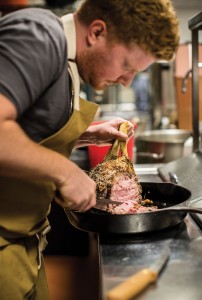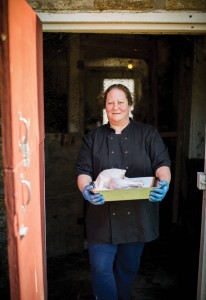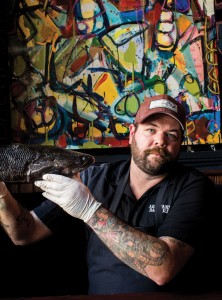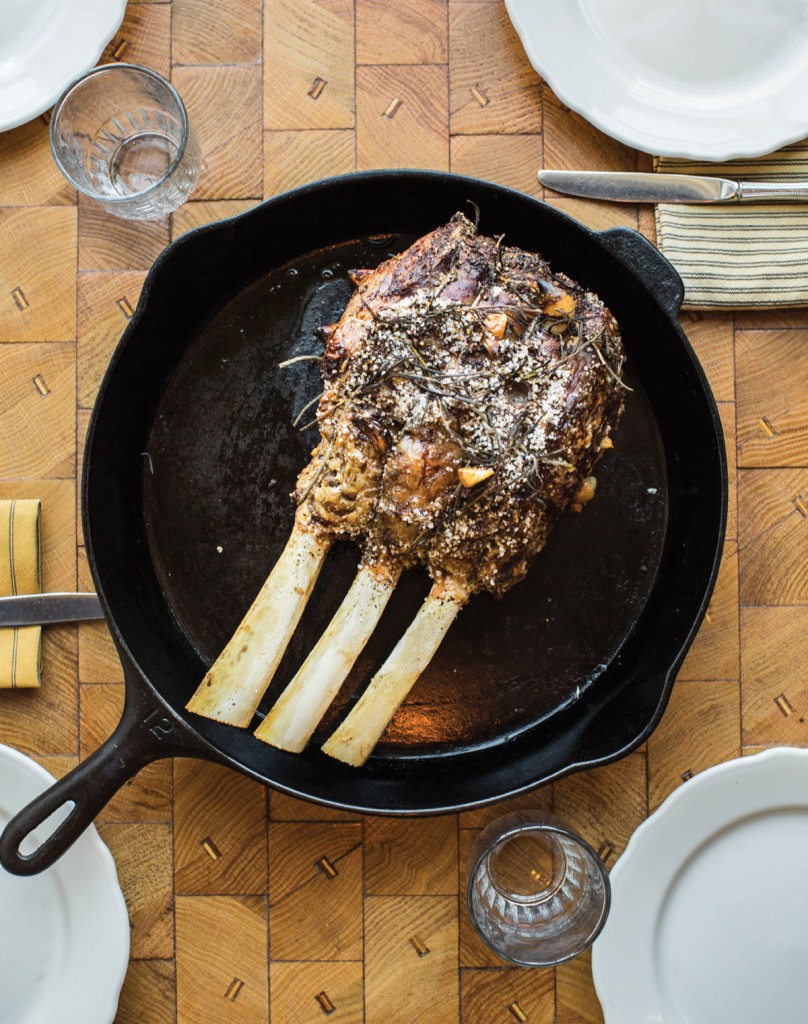Eating local foods has been a trend for more than a decade—after all, the Oxford English Dictionary designated “locavore” as its word of the year in 2007. But what does it really mean to eat sustainably? For George Marsh, the butcher at Parts & Labor, it’s choosing cuts of meat with funny names. For Chad Wells, it means frying up a snakehead fillet to keep the ugly invasive fish from devouring the Chesapeake Bay’s native creatures. And just about everything Robin Way’s family eats comes from their own land or from their neighbors’. Food editor Martha Thomas sat down with these three locals to learn more about their respective crafts—and to pick up a few cooking tips too.

George Marsh
Over a Barrel
If George Marsh had his way, all his customers would be eating knuckle sandwiches.
The goofy names that help George Marsh sell his steaks leave him a little peeved.
“Nobody wants the barrel,” he says, referring to a cut from the large knuckle —or back haunch—of the steer. “It’s a great cut,” he explains. “You could trick people and tell them it’s filet mignon.” Even so, when barrel steak was listed on the Parts & Labor menu, it just didn’t sell. One day the kitchen crew suggested branding the cut “cattlemen,” after the restaurant’s popular bean dish with the same name.
“It was a joke,” says Marsh. “They thought people could relate to cowboys.” But that night, Marsh recalls, “we sold out.” The steak is so popular that people come into the adjacent butcher shop and ask for the cattlemen cut. “Every so often I do little experiments and list it on the menu as barrel for a night,” Marsh says. And it doesn’t budge.
He’s since used the trick on another knuckle cut, this one generally called the knuckle. “I figured we have bavette and coulotte steaks, these pretty French names,” he reasons. “What’s the French word for knee? Genou.”
Marsh, who cuts up beeves for Woodberry Kitchen and its affiliated restaurants, Artifact, P&L and the former Shoo-Fly in Belvedere Square, says that the best way to appreciate the whole animal—and indeed, the art of butchery—is to try everything. It irritates him that people steer away from the less familiar. “I spend so much time doing everything we’re doing, and people make their decisions based on a word,” he says.
Poor mutton suffers a similar bias. “Mutton is an amazing meat,” says Marsh, “People like lamb. Then there’s a hogget—that’s in between—and they’re definitely not going to buy that.” Marsh says that in many ways he prefers mutton to beef. “I would love to have it in the case all the time. But nobody buys it because it’s a very unattractive word.”
Marsh was a chef at Woodberry Kitchen when he started messing around with carcasses. Woodberry’s philosophy, which involves working with meat from small producers, demands that the restaurant find uses for all parts of the animal, says Marsh. “When you’re doing a whole animal, you can’t pick and choose.” Marsh began to teach himself to break down animals. “I started pulling myself off the [kitchen] line and created this full-time butchery job for myself,” he says. “We’d get a steer a week, and two or three pigs.”
The process involved experimenting with cooking methods for different cuts, says Marsh. “This is where being a chef came in handy.” Looking for ways to use bottom round, for example, Marsh tried it seared (“a little too lean”) and made into corned beef (“personally, I like my corned beef to be brisket”). Finally, he tried using the cut chopped and raw, for tartare. “It is the best tartare,” he says. “Bottom round is a flavorful-but-tough cut,” and unlike those with finer muscle fiber that can end up without definition, it “has some integrity.”
Eventually, his boss, Spike Gjerde, decided to open a butcher shop and restaurant, with Marsh as the head butcher. For Marsh, the timing was ideal. “A chef is always at work. But I have kids now. I felt like I was missing their childhood.” He figured running the butcher shop would mean a more regular schedule.
A good butcher, says Marsh, can be judged on the amount of hamburger in the case. “The better you get, the less ground beef you have,” he says, describing the fate of cuts that people don’t want to buy. A small butcher shop that does whole animal butchery, he points out, “is not always going to have ribeye or fillet or strips. You’ll have ribeye on Monday and Tuesday, but by the end of the week, you’ll have a whole lot of grumpy people.” Unless, of course, they go for the knuckle.
Steak TIPS:
There’s never an exact time and temperature when it comes to cooking meat, says George Marsh, butcher at Parts & Labor in Remington. The meat is always different. Fat content, aging and cut can affect cooking times.
“The first thing is, use your senses,” he says. “If you cook a lot you start to understand how things will work. If you screw it up, that’s OK. You get carried away with a bottle of wine and you forget. I’ve overcooked steaks, eaten them medium well. The meat is still really good. Use a meat thermometer you can leave in the meat, not one you’re poking in the meat all the time. Pop the grill lid every once in a while and check the temp. Don’t cut a piece off.”
According to Marsh, “a lot of people miss the last, most crucial step: letting the meat rest. Sometimes,” he says, “a steak might rest up a temp,” so if you want your steak medium, take it off when it’s on the rare side. “The bigger the piece, the longer the rest. A 16-ounce ribeye might need many as 10 minutes to rest. A turkey needs 45 minutes to an hour.”

Robin Way
Rafter to Rafter
While poultry may be short- term residents on a farm, they provide lasting good.
When Robin Way and her husband, Mark, moved to the 62-acre Rumbleway Farm in 1992, organic food wasn’t yet “a thing,” she says, but after five years, they saw the trend afoot and began the three-year process of organic certification, which they completed in 1999. “We didn’t spray or anything, but we wanted the public to feel comfortable coming to our farm and know we weren’t doing anything we shouldn’t be doing,” she explains.
The Ways are old-fashioned farmers in the Wendell Berry mold, operating multiple small businesses. They sell eggs and poultry retail and wholesale, raise pastured beef and foraging pigs, and operate a small shop on their Cecil County farm where Robin sells her pickles and fruit jams, as well as eggs and meat. Robin even hosts dinners and cooking classes in a commercial kitchen in one of the outbuildings.
On a typical day in early autumn after driving her son to school, Way harvested the remaining tomatoes from the garden for canning, and peeled and chopped peaches. “We have a friend with an orchard who gets rid of the seconds and thirds,” Way says. “We climb on the truck and pick out what’s usable. We make peach wine and jam and everything else goes to the pigs,” who eat the fruit “and spit out the pit.” Any waste goes on the compost or to feed the worm beds, which in turn, fertilize the garden. While they don’t have a milk cow, the Ways trade meat and produce with a neighbor for a few gallons a week, some of which Robin turns into yogurt.
“A hundred years ago, families would own a cow for milk, chickens for meat and eggs. You’d have sheep if you wanted wool to make clothes, and you had to plant crops to feed your animals and family,” says Way. “Farming was never about raising 5,000 acres of corn and nothing else.”
Chickens and turkeys are part of the cycle at Rumbleway Farm, though Way describes them as “short-timers,” with a lifecycle of eight to 12 weeks compared to a couple of years for beef cattle. “But they give a lot of nutrients to the soil, and they’re pretty hardy,” she points out. “They fit in well in a small farm.” The Ways use hoop house-style coops on wheels with hanging water troughs, moved once a week to fresh pasture. The hundreds of birds can move freely, pecking in the soil for bugs and leaving just enough waste to fertilize the ground without oversaturation. “It’s a healthy lifestyle, moving around in the fresh air and sunshine,” says Way. And it means meat and eggs higher in healthy omega 3 fatty acids and lower in omega 6, which is related to high cholesterol and heart disease, she claims.
While Rumbleway once raised heritage turkeys, these days the farm sticks with the white-feathered birds. They get a rafter of poults each autumn to fatten up in time for the winter holidays.
Poultry raised on a farm, says Way, tastes the way it’s supposed to taste. “I think the birds have a bird taste,” she says. “Chicken tastes like chicken. Turkey tastes like turkey.” Turkeys are curious, adds Way. “They want to run around and fly. They need a combination of good food and good air,” and in turn, “will keep the ground healthy for the other animals.” This, she tells me, is what farming is all about. “It’s about a sustainable piece of ground that you can use to feed your family. It’s about healthy ground and a healthy life.”
Turkey TIPS:
Heritage turkeys are a little tougher than their white-feathered friends, and any bird raised on pasture—as the Rumbleway poultry are—will be leaner than their factory-bred counterparts. Otherwise, says Robin Way, “Poultry is poultry. They have two breasts, two legs and two thighs.”
The ratio of white to dark meat in a heritage bird is closer to 50:50, while white birds are bred to be breast-heavy. Dark meat takes longer to cook, so Way recommends cooking heritage turkeys breast side down, so the breast stays moist in the cooking juices.
Way starts by oiling the bird with olive or avocado oil, then stuffs it with cornbread, celery and onions. “I let it cook low and slow at 325 degrees, basting it as much possible. The only time I uncover the bird is to brown it at the very end for half an hour, basting it every 10 minutes or so,” she says. “Don’t be intimidated; it’s basically a big chicken. Just cook it until it’s done.”

Chad Wells
Frankenfish Fillet
To rid the Chesapeake Bay of its ugliest predator, fry it up and put it on a roll.
The first fish that Chad Wells, chef at Alewife restaurant, ever caught was at the manmade Lake Elkhorn in Columbia. “If I had to guess, I was 5 years old,” says Wells, who grew up in Ellicott City. “My dad used to take me fishing and we caught this fish and put it in the aquarium at my house. It destroyed the tank and we ended up taking it back and letting it go.”
These days Wells catches fish far more destructive than that little sunfish. He’s become known for using blue catfish and snakeheads, both invasive species found in Maryland waters, in dishes at the Eutaw Street gastropub. His snakehead cake is a compact patty served on a bed of fresh corn and cilantro pesto. The flavor is mild, and the texture not unlike the white flaky fish he’s seeking to mimic. “If you were to put snakehead flesh on a plate raw, next to any fish you eat on a regular basis—cod, for instance—you’ll never know this is an ugly creature,” says Wells. “It’s the same thing when you taste the fish.”
The goal, he says, is “to slowly introduce people to something new,” so there’s no reason to go too far with the ick factor. “I’m not going to pair snakehead and sheep’s brain, for instance,” he says. “People will be turned off if they think you’re just trying to be gross.” Instead, “I’ll make something people are already used to seeing, like a po’boy sandwich or snakehead cakes—my take on a coddie.”
Snakeheads have been prowling Maryland waters for more than 15 years—since the first “Frankenfish” was found in a Crofton pond, possibly released from a home aquarium. “It looks like a python,” says Wells. “It has big teeth, and they have a long fin that goes from head to tail. I think they’re badass.” These days, the slithery creature is found throughout the region. “I’ve been catching them in the upper Chesapeake,” says Wells.
Equally threatening, maybe even worse, are blue catfish. These predators, native to southern rivers, can grow to around 100 pounds (a record 143-pound blue cat was certified in Virginia in 2011). Described by one employee of the Department of Natural Resources as “a vacuum cleaner with fins,” the oversized fish has an appetite for anything in its path, particularly native mussels. “They’re too big for our environment,” says Wells. “When you’re talking about a 100-pound fish in a river system, that’s a pretty dominant predator.”
The good news is, the fish is being eaten. Wells serves blue cat as fish tacos, and other restaurants use it for any number of dishes that call for a firm, flakey fish. The fish is available at Mom’s Market and Whole Foods, he says. “If you order catfish from any distributor, you’ll get blue catfish.”
Wells would prefer to catch the fish that goes on the menu at Alewife, but regulations prevent him from doing so. A friend recently got a commercial permit and operates as Southern Maryland Invasive Bowfishing, so is able to source much of the fish Wells serves at Alewife.
Meantime, Wells keeps fishing. “When my son takes a nap, I’m going fishing. When he goes to bed, I’m going fishing,” says the chef. “I fish a lot. It’s a problem.” For Wells, fishing provides the stress relief all chefs need. “Sometimes, I’ll just get up early and stand on the pier and practice with my fly rod,” he says. “The old day is washed away, the new day is going to start, and I feel better.”
Fishing, he adds, “keeps me connected with the outdoors. The outdoors inspires me, especially when it comes to everything in the kitchen. I feel like nature should be every chef’s best friend.”
FISH TIPS:
Snakehead is an easy fish to cook, says Alewife chef Chad Wells. With its dense texture and lean meat, he says, “you can bake it, you can sauté it, you can fry it and you can grill it.” It has the flavor profile of a deep ocean fish, he says. But make sure you remove the skin, which has a bitter flavor. Where to find snakehead? “Catch it,” says Wells. “It’s time to take the gloves off. Eat as many as you can. Catch as many as you can.”
Standing Rib Roast
Serves 4-5
From George Marsh, Parts and Labor
Here are directions for a traditional holiday roast. Ask your butcher to French (or cut through the bones) and truss your roast.
4-5 pound rib roast (2-3 bones)
2 tablespoon coarse sea salt
1 tablespoon ground black pepper
8 cloves garlic
Several sprigs of fresh thyme and rosemary
Preheat the oven to 425 degrees. Using a boning/paring knife, pierce the roast making 10-20 small incisions, and stuff a garlic clove in each. Lace sprigs of rosemary and thyme into the trussing.
Season the roast liberally with salt and pepper, rubbing it in with your hands.
Place the roast in a roasting pan, bone side down. Roast at 425 degrees for 30-45 minutes, until a nice brown crust forms on top. Turn oven down to 300 degrees and finish for another 30-45 minutes. Roast is done when the internal temperature is 120 degrees. Don’t repeatedly poke the roast with the thermometer, as that can cause drainage of natural juices. Once the meat has reached 120 degrees, remove from oven and let rest for at least 20 minutes before slicing.
Turkey schnitzel with confit over mushroom risotto
Serves 10, easily
From Robin Way, Rumbleway Farm
This is an alternative way to use a whole turkey, at holiday time or any other time of year. The recipe uses all the turkey parts—the breast meat becomes schnitzel while the legs, thighs and wings are made into a confit.
1 small turkey (10-15 lbs)
3-4 whole garlic cloves
Olive oil, or fat from turkey
Flour for dredging
2 eggs beaten
panko or bread crumbs (seasoned to your taste)
Oil for frying
Salt and pepper
2 cups Arborio Rice
½ pound mushrooms,
chopped
6-8 cups chicken or turkey stock, hot
½ onion or shallot, diced
4 ounces white wine
Remove legs, wings and breasts from turkey. Reserve back bone and fat. Place wings, legs and back bone in a pot and cover with oil. Make sure all the pieces are submerged. Add salt and pepper and whole garlic cloves. Bring to a low simmer (lowest setting possible) and cook for 1 hour. Make sure the oil does not boil. Once turkey is tender, pour through a strainer and reserve oil for next time (freezes well). Once meat cools, remove and roughly chop.
While dark meat is cooking, cut breasts into several pieces and pound till thin. Place flour, egg and Panko in separate containers. Flour the breasts and dip in egg wash then in panko. Heat oil in a frying pan and brown breast pieces on both sides. Remove to parchment or paper towel lined tray. Sprinkle with salt and pepper if desired.
Heat a small amount of oil in a large skillet and cook onion and mushroom till tender. Add rice and sauté until all the grains are coated. Add wine and cook until evaporated. Reduce heat to low and start adding stock one cup at a time, allowing rice to absorb stock between each addition, frequently stirring. This step may take 30-45 minutes. Cook till risotto is tender. Salt and pepper to taste.
To plate, place risotto on plate and place turkey breast schnitzel on top, top with chopped confit and serve with your favorite vegetable or salad.
Snakehead cakes
Serves Serves 4 as an appetizer or 2 as a main course
From Chad Wells, Alewife
This is Wells’ take on traditional coddies, though using meat from the invasive snakehead.
3 eggs, lightly beaten
¼ cup of mayonnaise
10 chives, diced
1 tablespoon minced garlic
1 teaspoon sour cream
¾ pound cooked snakehead meat, flaked (can substitute
cod or another white fish)
2 cups leftover mashed potatoes
4 cups breadcrumbs
4½ teaspoons kosher salt
Cornstarch
All-purpose flour
Paprika
Pepper to taste
Oil for pan
Lemons and dipping sauces
(for serving)
Place mayonnaise, chives, garlic, sour cream, flaked snakehead meat and mashed potatoes into a mixing bowl. Season with salt and pepper to taste. Add beaten eggs and gently mash ingredients together by hand until combined. Add bread crumbs and continue to blend until the mixture can be molded by hand and hold its form.
Cover mixing bowl and refrigerate for 1 hour.
Once chilled, form mixture into 3 ounce cakes and set aside
Mix together cornstarch, flour, paprika, salt and pepper in a small mixing bowl. Dredge each cake on both sides in the flour mixture.
Heat oil in sauté pan and sear cakes on both sides over high heat until golden brown and heated all the way through, about 2 minutes per side.
Serve with your favorite seafood dipping sauce and fresh lemon. 9





